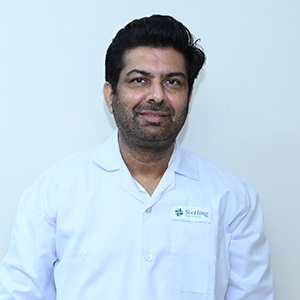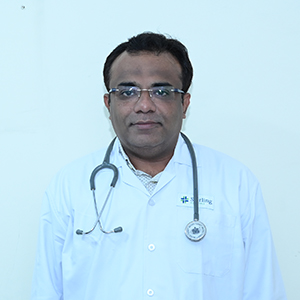General Surgery
The Department of General Surgery at Sterling Hospitals Rajkot, provides comprehensive care for a wide range of surgical problems involving the abdomen. The department uses the latest techniques, including minimally invasive surgery, and has a team of experienced surgeons. The department also takes a multi-disciplinary approach to complex cases, working with other specialists such as gastroenterologists, radiologists, and pathologists.
Here are some of the services offered by the Department of General Surgery:
-
Upper gastrointestinal (UGI) surgery
-
Hepatobiliary pancreatic surgery
-
Colorectal surgery
-
Laparoscopic and endoscopic surgery
-
Other surgeries
The Department of General Surgery at Sterling Hospitals Rajkot, specializes in a wide range of surgeries, including UGI, hepatobiliary pancreatic, colo-rectal, and laparoscopic & endoscopic surgeries. The department has a team of experienced surgeons who use the latest techniques to provide the best possible care for their patients.
Here is a brief overview of the services offered by the department:
-
UGI surgery includes gastrectomy, esophagectomy, small bowel resection, and anastomosis.
-
Hepatobiliary pancreatic surgery includes pancreatic surgery, Whipple's surgery, and liver resection.
-
Colo-rectal surgery includes haemorrhoidectomy, stapled haemorrhoidectomy, fistulas & fissures, appendix surgery, different types of colectomies, anterior resection, and abdominoperineal resection.
-
Laparoscopic & endoscopic surgery includes laparoscopic appendicectomy, laparoscopic cholecystectomy, laparoscopic hernia repair, and laparoscopic small intestinal and colorectal surgery.
The department also provides other surgeries such as
-
Hernia Surgery
-
Trauma Surgery
-
Breast Surgery for benign & malignant disease
-
Hydrocele
-
Thyroid & Parathyroid surgery
-
Parotid and Submandibular gland surgery
-
Varicose Vein Surgery.
In conclusion, the Department of General Surgery at Sterling Hospitals Rajkot, , provides comprehensive care for a wide range of surgical problems with a multi-disciplinary approach, employing the latest non-invasive and minimally invasive techniques whenever possible. The department is staffed by highly skilled and experienced surgeons who are dedicated to providing the best possible care to patients.
Common procedures
- Hernia repair: Hernia repair is a surgical procedure that involves repairing a weakened area in the abdominal wall through which an internal organ, typically the intestines, protrudes.
-
Cholecystectomy: Cholecystectomy is a surgical procedure that involves removing the gallbladder, typically due to the presence of gallstones or other gallbladder diseases.
-
Appendectomy: Appendectomy is a surgical procedure that involves removing the appendix, typically due to acute or chronic appendicitis.
-
Colectomy: Colectomy is a surgical procedure that involves removing all or part of the colon, typically due to colon cancer, inflammatory bowel disease, or diverticulitis.
-
Thyroidectomy: Thyroidectomy is a surgical procedure that involves removing all or part of the thyroid gland, typically due to thyroid cancer, an enlarged thyroid, or hyperthyroidism.
-
Mastectomy: Mastectomy is a surgical procedure that involves removing all or part of the breast tissue, typically due to breast cancer.
-
Haemorrhoidectomy: Haemorrhoidectomy is a surgical procedure that involves removing haemorrhoids, typically due to chronic or severe hemorrhoids that cause pain or bleeding.
Hernia Surgery
Hernia is a common medical condition that occurs when an organ or tissue pushes through a weak spot or tear in the muscles of the abdominal wall. Hernias can occur in different parts of the body, such as the groin, belly button, or upper thigh. They can be caused by a variety of factors, including genetics, age, chronic coughing, straining during bowel movements, heavy lifting, or obesity.
Hernia surgery is a surgical procedure that aims to repair the weakness in the abdominal wall that is causing the hernia. There are two main types of hernia surgery
-
Laparoscopic surgery is a minimally invasive procedure that involves making small incisions in the abdomen and inserting a laparoscope (a thin, lighted tube with a camera) and specialized surgical instruments to repair the hernia. Laparoscopic surgery is preferred for smaller hernias and has several advantages over open surgery, including less pain, a shorter hospital stay, and a faster recovery time.
-
Open surgery, on the other hand, involves making a larger incision in the abdomen and directly repairing the hernia. Open surgery is preferred for larger hernias or more complex cases, where it may be easier to visualize the hernia and repair it directly.
Risks In Hernia Surgery
Both laparoscopic and open hernia surgeries are generally safe, but have risks like bleeding, infection, and organ damage. Discuss your options with your surgeon to choose the best approach for you.
Recovery Post Hernia Surgery
Recovery time following hernia surgery can vary, but most patients are able to return to their normal activities within a few weeks. Pain and discomfort are common, but can be managed with medication. Patients may need to restrict their activities for a period of time to allow for proper healing.
Cholecystectomy
Cholecystectomy is a surgical procedure that involves the removal of the gallbladder, which is a small organ located under the liver. The main function of the gallbladder is to store bile, a substance that helps in the digestion of fats. Cholecystectomy is commonly performed to treat gallstones or other conditions that cause pain or inflammation in the gallbladder.
Indications for Cholecystectomy :
-
Gallstones: If gallstones are causing symptoms such as abdominal pain, nausea, vomiting, or bloating, cholecystectomy may be necessary.
-
Biliary dyskinesia: This is a condition in which the gallbladder does not empty bile properly, causing pain or discomfort.
-
Cholecystitis: This is inflammation of the gallbladder, which can be caused by infection or other factors.
-
Pancreatitis: In some cases, gallstones can cause inflammation of the pancreas, which may require cholecystectomy.
-
Gallbladder cancer: In rare cases, cholecystectomy may be performed to remove cancerous tumours of the gallbladder.
Risks Involved
-
Bleeding
-
Infection
-
Injury to the bile duct or other nearby organs
-
Reaction to anesthesia
-
Blood clots
Recovery after Cholecystectomy:
Most patients are able to go home the same day or the day after surgery. Recovery time depends on the patient's age, overall health, and the type of surgery. Some discomfort or pain is expected for several days, and pain medication may be prescribed. Most patients can resume normal activities within a few days to a week.
It is important to follow your doctor's instructions for post-operative care, including diet and activity restrictions. A normal diet can usually be resumed within a few days, but fatty or greasy foods should be avoided for a few weeks to allow the digestive system to adjust. Light exercise, such as walking, can help speed up the recovery process.
At Sterling Hospitals Rajkot, , we are committed to providing the highest quality of care for our patients undergoing cholecystectomy and other surgical procedures. Our state-of-the-art facility and skilled team of professionals make us a leading surgical hospital in .
Appendectomy
Appendectomy is a surgical procedure to remove the appendix, a small, finger-shaped organ that projects from the colon. Appendectomy is typically performed to treat acute appendicitis, a condition in which the appendix becomes inflamed and infected. If left untreated, acute appendicitis can rupture, leading to serious complications such as peritonitis, abscess formation, or sepsis.
Appendectomy can also be performed for other reasons, such as:
-
Recurrent episodes of appendicitis: Patients who have had multiple episodes of appendicitis may require surgery to prevent future attacks.
-
Tumors or cancer of the appendix: Although rare, tumors or cancer of the appendix may require surgical removal.
The decision to perform an appendectomy is typically made by a surgeon based on the patient's symptoms, physical examination, and diagnostic tests, such as imaging studies or blood tests.
The indications for appendectomy include symptoms such as:
-
Abdominal pain, usually in the lower right abdomen
-
Fever
-
Nausea and vomiting
-
Loss of appetite
The surgery is typically performed under general anesthesia. There are three main approaches to performing an appendectomy: laparoscopic, open, and robotic.
-
In laparoscopic appendectomy, the surgeon makes several small incision in the abdomen and inserts a laparoscope and other instruments to remove the appendix. This procedure is less invasive than open surgery, which requires a larger incision in the abdomen. Laparoscopic appendectomy results in less pain, a shorter hospital stay, and a faster recovery time.
-
In an open appendectomy, the surgeon makes a larger incision in the abdomen to remove the appendix. This approach may be necessary if the appendix has ruptured, if the patient has had previous abdominal surgery, or if the surgeon has difficulty visualizing the appendix with the laparoscope.
-
Robotic appendectomy is a newer technique that uses the da Vinci Surgical System, a robotic platform that allows the surgeon to operate with enhanced precision and control. The surgeon sits at a console and uses hand and foot controls to maneuver the robotic arms and instruments. The robotic system provides a 3D high-definition view of the surgical site, and the instruments can rotate and bend in ways that are difficult with traditional laparoscopic instruments.
While each approach has its benefits and risks, the choice of technique depends on various factors such as patient anatomy, surgeon expertise, and the severity of the appendicitis. The surgical team at Sterling Hospitals is well-equipped to perform all types of appendectomies and determine the best approach for each patient.
Recovery after appendectomy typically involves a short hospital stay of one to two days, during which time the patient may receive pain medication and be encouraged to walk and resume a normal diet. The patient will need to avoid strenuous activities for several weeks and follow up with their surgeon to ensure proper healing.
At Sterling Hospitals Rajkot, , our team of experienced surgeons and healthcare professionals are dedicated to providing the highest quality of care for our patients undergoing appendectomy and other surgical procedures. Our state-of-the-art facility and advanced technology make us a leading surgical hospital in . We provide personalized care and support to ensure a smooth and comfortable recovery for our patients.
Colectomy
Colectomy is a surgical procedure that involves the removal of all or part of the colon (large intestine). The decision to perform a colectomy is typically based on the patient's symptoms, physical examination, and diagnostic tests such as imaging studies, colonoscopy, or biopsy results.
The indications for colectomy may include:
-
Cancer or precancerous growths: Patients with colon cancer or precancerous growths (polyps) may require surgery to remove the affected tissue and prevent the spread of cancer cells.
-
Inflammatory bowel disease: Patients with IBD, such as ulcerative colitis or Crohn's disease, may require surgery if medical treatments fail to control symptoms or if complications such as bowel obstruction or perforation occur.
-
Diverticulitis: Patients with diverticulitis, a condition characterized by inflamed pouches in the colon, may require surgery if they experience recurrent attacks or complications such as abscesses or fistulas.
The surgery is typically performed under general anesthesia and can be done through either a traditional open approach or a minimally invasive laparoscopic approach.
-
In open colectomy, the surgeon makes a larger incision in the abdomen to remove the affected part of the colon. This approach may be necessary for patients with extensive disease, scar tissue from previous surgery, or other factors that make laparoscopic surgery difficult.
-
In laparoscopic colectomy, the surgeon makes several small incisions in the abdomen and inserts a laparoscope and other instruments to remove the affected tissue. This approach results in less pain, a shorter hospital stay, and a faster recovery time compared to open surgery.
-
In some cases, a robotic colectomy may be performed using the da Vinci Surgical System, a robotic platform that provides enhanced precision and control for the surgeon. The robotic system allows for a 3D high-definition view of the surgical site and greater manoeuvrability of the instruments.
The choice of technique depends on various factors, such as the location and extent of the affected tissue, patient anatomy, and surgeon expertise. The surgical team at Sterling Hospitals is experienced in performing all types of colectomies and will determine the best approach for each patient.
Recovery after colectomy typically involves a hospital stay of three to seven days, during which time the patient may receive pain medication and be encouraged to walk and resume a normal diet. The patient will need to avoid strenuous activities for several weeks and follow up with their surgeon to ensure proper healing.
At Sterling Hospitals Rajkot, , our team of skilled surgeons and healthcare professionals are committed to providing exceptional care and support for patients undergoing colectomy and other surgical procedures. Our state-of-the-art facility and advanced technology make us a premier surgical hospital in . We provide personalized care and attention to ensure a smooth and successful recovery for our patients.
Thyroidectomy
Thyroidectomy is a surgical procedure that involves the removal of all or a portion of the thyroid gland. The thyroid gland is a butterfly-shaped gland located in the neck that produces hormones that regulate the body's metabolism.
Thyroidectomy may be indicated for a variety of conditions, including:
-
Thyroid cancer: If a patient has been diagnosed with thyroid cancer, they may need to undergo a thyroidectomy to remove the cancerous cells.
-
Hyperthyroidism: If a patient has an overactive thyroid gland that cannot be controlled with medication, a thyroidectomy may be necessary to remove all or a portion of the gland.
-
Goitre: A goitre is an enlargement of the thyroid gland that may cause difficulty breathing or swallowing. In some cases, thyroidectomy may be recommended to alleviate these symptoms.
-
Suspicious thyroid nodules: If a patient has a suspicious nodule on their thyroid gland that may be cancerous, a thyroidectomy is recommended to remove the nodule for biopsy.
-
Recurrent thyroid cysts: Recurrent thyroid cysts may require surgical removal of the affected part of the thyroid gland.
The decision to perform a thyroidectomy is typically made by a surgeon based on the patient's symptoms, physical examination, and diagnostic tests, such as imaging studies or blood tests.
There are three main types of thyroidectomies:
-
Total thyroidectomy: In this procedure, the entire thyroid gland is removed.
-
Partial thyroidectomy: In this procedure, a portion of the thyroid gland is removed.
-
Thyroid lobectomy: In this procedure, only one lobe of the thyroid gland is removed.
The surgical team at Sterling Hospitals is well-equipped to perform all types of thyroidectomy surgeries and determine the best approach for each patient. The surgery is typically performed under general anesthesia, and the patient may need to stay in the hospital for one to two days after the procedure.
Recovery time varies depending on the type of thyroidectomy performed, but most patients can return to their normal activities within a few weeks.
At Sterling Hospitals , our team of experienced surgeons and healthcare professionals are dedicated to providing the highest quality of care for our patients undergoing thyroidectomy and other surgical procedures. Our state-of-the-art facility and advanced technology make us a leading surgical hospital in . We provide personalized care and support to ensure a smooth and comfortable recovery for our patients.
Mastectomy
Mastectomy is a surgical procedure that involves the removal of one or both breasts, typically as a treatment for breast cancer. The type of mastectomy recommended by a surgeon depends on the stage of the cancer, as well as other factors such as the size and location of the tumor.
Indications for mastectomy include:
-
Breast cancer: Mastectomy is often recommended for patients with breast cancer, particularly if the tumor is large or if there are multiple tumors in the breast. Mastectomy may also be recommended for patients who have a high risk of developing breast cancer due to genetic mutations or other factors.
-
Breast abscess: In some cases, a breast abscess may require surgical removal of the breast tissue.
-
Male breast cancer: Although rare, breast cancer can occur in men and may require mastectomy for treatment.
The procedure is typically performed under general anesthesia and may involve the removal of the entire breast (total mastectomy) or just the breast tissue (partial mastectomy). In some cases, the surgeon may also remove nearby lymph nodes to check for the presence of cancer.
There are several different types of mastectomy, including:
• Simple or total mastectomy: This involves the removal of the entire breast but not the lymph nodes under the arm.
• Modified radical mastectomy: This involves the removal of the entire breast and some lymph nodes under the arm.
• Radical mastectomy: This involves the removal of the entire breast, some lymph nodes under the arm, and the chest wall muscles.
• Skin-sparing mastectomy: This involves the removal of the breast tissue but preserves the breast skin for reconstruction.
• Nipple-sparing mastectomy: This involves the removal of the breast tissue but preserves the nipple and areola for reconstruction.
The recovery period after mastectomy varies depending on the extent of the surgery and the individual patient's healing process. Typically, patients will need to stay in the hospital for a few days after the surgery and will experience pain and discomfort for several weeks. The surgical team will provide pain management and other supportive care to ensure a smooth and comfortable recovery.
At Sterling Hospitals Rajkot, , our experienced team of surgeons and healthcare professionals are dedicated to providing the highest quality of care for our patients undergoing mastectomy and other surgical procedures. Our state-of-the-art facility and advanced technology make us a leading surgical hospital in . We provide personalized care and support to ensure a smooth and comfortable recovery for our patients.
Haemorrhoidectomy or Piles Surgery
Haemorrhoids, also known as piles, are swollen and inflamed veins in the lower rectum and anus. They can be either internal, located inside the rectum, or external, located under the skin around the anus. Haemorrhoids can cause discomfort, pain, itching, and bleeding, especially during bowel movements. They are a very common condition, affecting both men and women, and can be caused by factors such as straining during bowel movements, sitting for long periods of time, obesity, pregnancy, and a low-fibre die
Haemorrhoidectomy is a surgical procedure performed to remove haemorrhoids, which are swollen veins in the rectum or anus. Haemorrhoids can cause discomfort, bleeding, itching, and pain, and may lead to complications such as thrombosis or strangulation of the tissue.
The procedure is indicated when non-surgical treatments such as lifestyle changes, topical medications, or minimally invasive procedures such as rubber band ligation or sclerotherapy have failed to relieve symptoms.
The surgery can be performed using different techniques depending on the severity of the haemorrhoids and the preference of the surgeon :
-
In an open haemorrhoidectomy, the surgeon makes incisions around the haemorrhoids and removes them. This approach is effective but may be associated with more pain and a longer recovery time compared to closed haemorrhoidectomy.
-
In a closed haemorrhoidectomy, the surgeon uses a circular stapling device to remove the haemorrhoids without making external incisions. This technique may be associated with less pain and a faster recovery time, but may not be suitable for all cases.
-
In a stapled haemorrhoidectomy, the surgeon uses a special stapling device to remove the haemorrhoids and reposition the tissue. This technique may be associated with less pain and bleeding compared to other techniques but may not be suitable for all cases.
Like any surgical procedure, haemorrhoidectomy may be associated with risks such as bleeding, infection, pain, or damage to surrounding tissue. However, these risks are generally low and can be minimized with proper surgical technique and postoperative care.
Recovery after haemorrhoidectomy typically involves a few days of pain medication and limited physical activity, such as avoiding heavy lifting or strenuous exercise. Patients may also need to modify their diet and bowel habits to prevent constipation and strain during bowel movements.
At Sterling Hospitals Rajkot, our team of experienced colorectal surgeons and healthcare professionals provide comprehensive care for patients undergoing haemorrhoidectomy. We use the latest surgical techniques and equipment to ensure the best possible outcomes for our patients. Our personalized approach and commitment to quality care make us a leading hospital for colorectal surgery in












